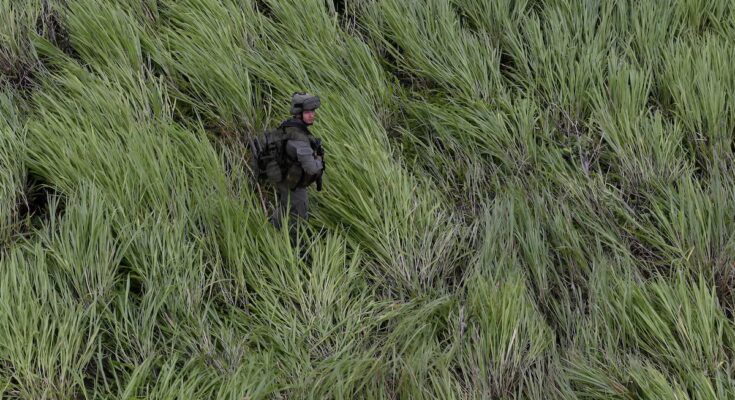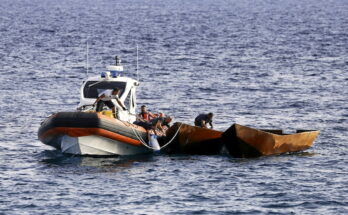At dawn on November 13, the Colombian jungle creaked in darkness. A column of 150 guerrillas, camouflaged in olive green, advanced through the undergrowth with the aim, the Ministry of Defense said, of ambushing a group of 20 young soldiers deployed in the area. In the platoon there were two priority targets for the authorities: trusted men of Ivan Mordisco, alias of the guerrilla who leads a dissident group of the FARC and one of Colombia’s most wanted criminals. They didn’t get that far. Three planes dropped several bombs on their heads. They also surrounded them by land. The order was given by the President of Colombia, Gustavo Petro, while receiving dozens of world leaders at the CELAC summit, on the shores of the Caribbean Sea. The main targets fled, but 19 rank-and-file fighters were killed in the attack. Seven were minors forcibly recruited by the guerrillas. Carem Smith Cubillos Miraña was 13 years old. The oldest, Martha Elena Abarca Vilches, 17 years old.
The bombing, which occurred in the Amazon region of Guaviare, triggered a political earthquake whose aftershocks continue 10 days later. Petro acknowledged that he knew minors could die and took responsibility. But he didn’t back down. His strong support for the Defense Minister, retired general Pedro Sánchez, has disconcerted his bases: a left that can hardly defend an operation in which children, themselves victims of the conflict, died. The president had broken one of the limits he himself had set: avoiding armed operations when minors were present. “It wasn’t a kindergarten. It was an armed camp,” Sánchez justified.
The crisis, far from having subsided, intensified this week. After the bombing of Guaviare became known, details of another military operation that took place in the Amazon department a month earlier came to light. The troops searched for Ivan Mordisco again, but instead captured four people and killed four others. Everyone – living and dead – was a minor. Four more children fell without managing to hit the hearts of the guerrillas. One of the injured is just 10 years old. The Army reported that it had neutralized the Mordisco security network, a purported network made up of soldiers aged between 10 and 15. Two more attacks in August killed four more children. The dispute is a political, ethical and security cocktail.
The war – silent far from Colombia, thunderous at home – once again presents the country with a familiar dilemma. In 2019, under the government of Ivan Duque, the death of at least seven minors in an attack led to the fall of Defense Minister Guillermo Botero. Two years later, another attack that killed seven more children politically undermined his successor, Diego Molano. From the opposition, Petro was a fierce critic of those murders. And when he became president he limited the attacks when there were indications of the presence of minors. “We must prevent war from continuing to take children away,” he said. It was his red line.
But, to the surprise of its bases, it blew it up, leaving more than a dozen dead children in its wake and failing to capture its main targets. The same people who attacked Duque are now justifying the attacks. Petro, who condemned Donald Trump’s attacks on drug boats in the Caribbean, has lost coherence in his argument.
The government proposes a perverse paradox that also defends the right: if the state stopped bombing to avoid the death of minors, armed groups could use more and more children as shields. “To say that bombing in the offensive actions of drug traffickers should stop is to invite them to recruit more boys and girls,” Petro warned. The president’s allies have focused on the cruelty of child recruitment – which the state is powerless to stop – and not on the lethal military operation, but on the more ideological left that this issue hurts. And divide.
Even historic human rights figures, such as Ivan Cepeda, candidate to succeed Petro, have avoided firm positions. Opposition MP Katherine Miranda publicly called on him: “Dear Ivan Cepeda, I invite you to denounce President Petro and Minister Pedro Sánchez for serious violations of international humanitarian law. Consistency does not depend on the government in power.”
The debate also reopened another concern: the state of Colombian intelligence. “Suppose that Operation Guaviare was defensive to save the lives of those 20 soldiers. What about the rest?” asks Vladimir Rodríguez, a former official of the Ministry of Defense during the period in which the Petro government suspended operations that put minors at risk. “I’m not against bombings, but they have to be done well. Intelligence should allow us something surgical. We have to kill the recruiter, not the recruit.” For him the problem is clear: “Ground intelligence or the way it is processed to reach the president is failing.” Since the beginning of his mandate, Petro has received criticism on this front: he replaced experienced officers, appointed commanders with less experience and announced breaks with international cooperation organizations.
The bombs, in any case, resurrect a frightening and silent reality: the recruitment of hundreds of boys and girls every year. A warfare practice that usually takes place far from capitals. In inaccessible regions where the State does not appear, where the law is not applied. In places where mothers have all their children kidnapped and when they are murdered they cannot go and bury them for fear that they will be killed too.
It is one of the most difficult crimes to document. In 2024, the Prosecutor’s Office received 604 complaints. But in the first half of this year alone, the Cauca department recorded 800 cases. The figures, however, cannot cover the phenomenon, which is now also expanding through social networks. In August, the Special Jurisdiction for Peace warned that TikTok has become a key means of luring minors into war.
But recruiters continue to look mostly at rural schools. There they find poverty, abandonment and an absent state. They force them, but they also convince them. “They start paying them 100,000 pesos – about 25 dollars – and they tell them that as fighters they can earn two or three million,” Emilse Jiménez, leader and defender of minors’ rights, explained to EL PAÍS. For many children the only path that offers a future is war.



